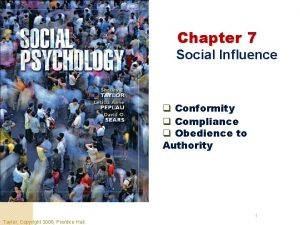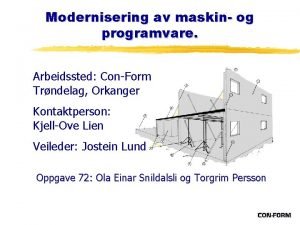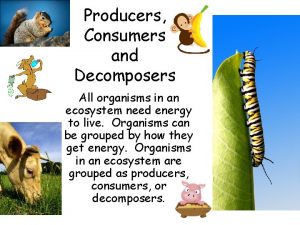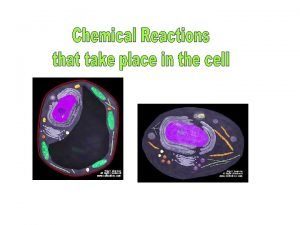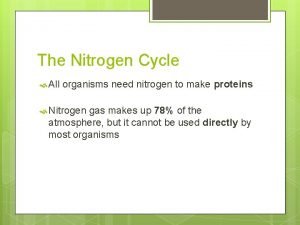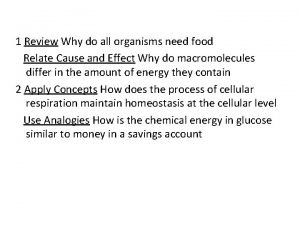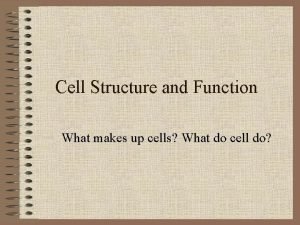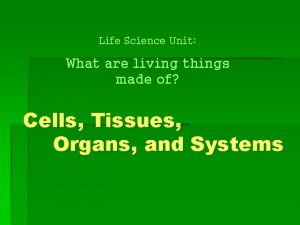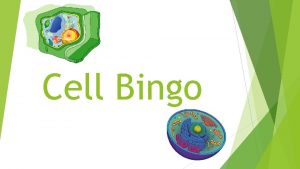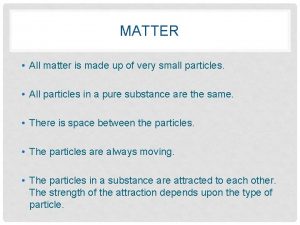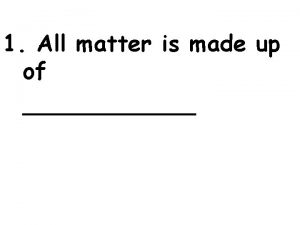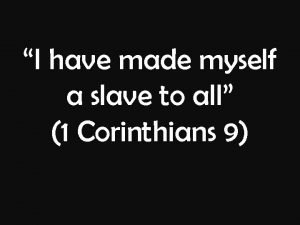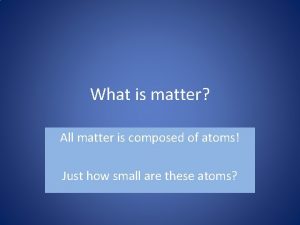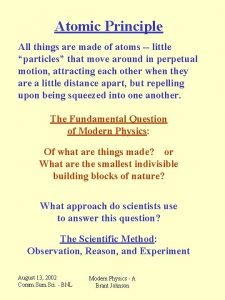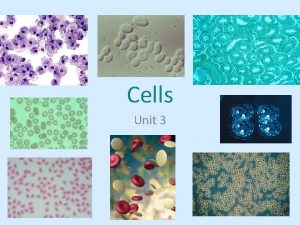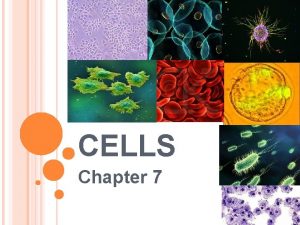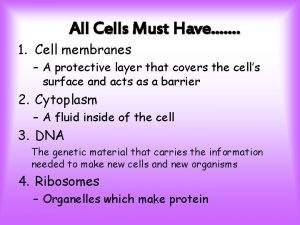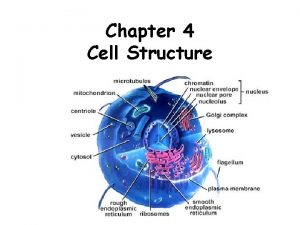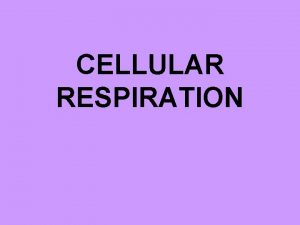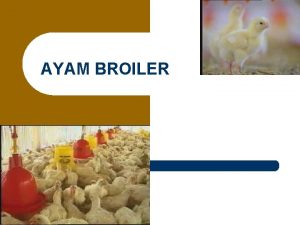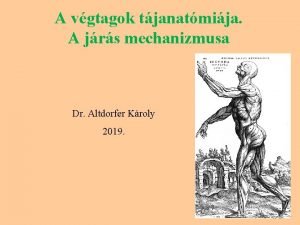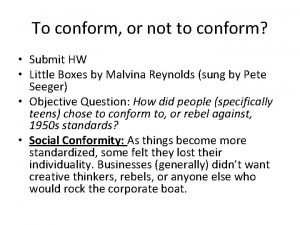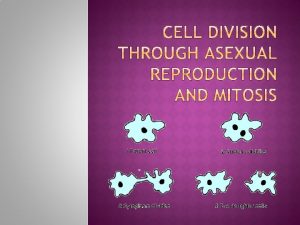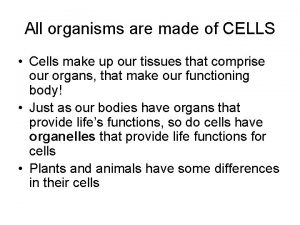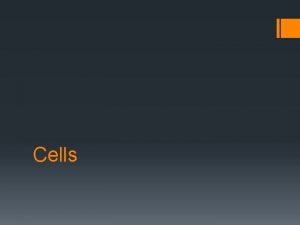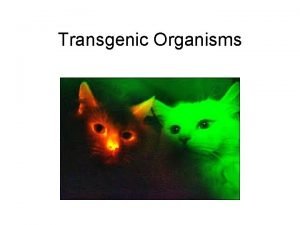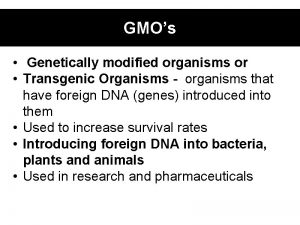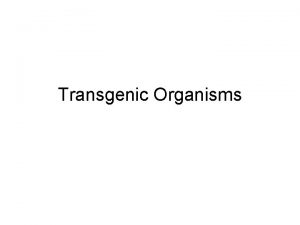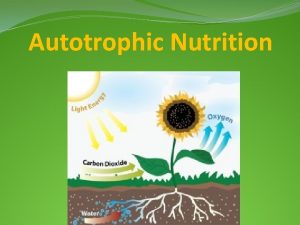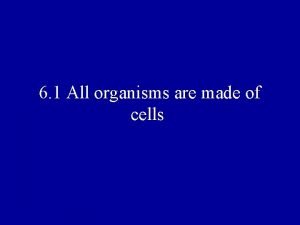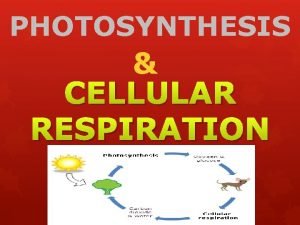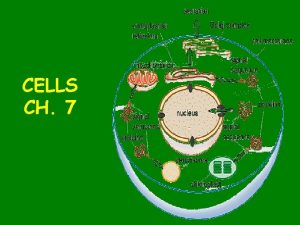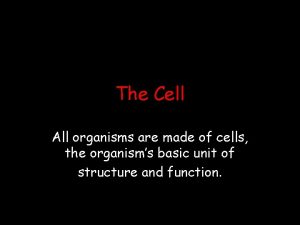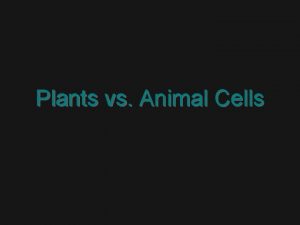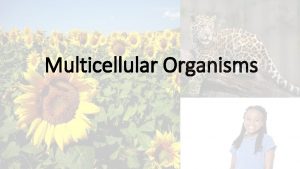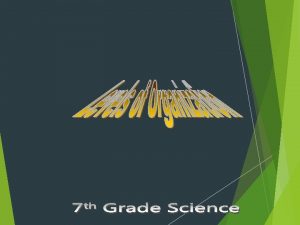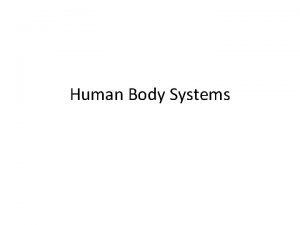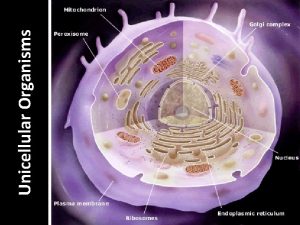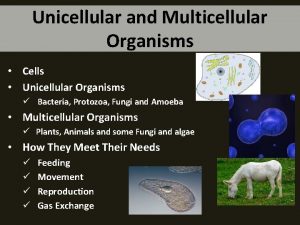All organisms are made of cells Cells conform

























































- Slides: 57


All organisms are made of cells Cells conform to the definition of life

CELLS… • Reproduce • Obtain energy and materials from their food • Change with time • Respond to their environments • Highly organized

Invention of the compound Microscopes • 1595 • credited to Zacharias Janssen • eyeglasses beginning to be used; lots of focus & great deal of attention to optics and lenses • magnifying images • probably helped by his approximately three father Hans times when fully closed • slide the draw tube in or and up to ten times out while observing the when extended to the sample maximum


First Living Cells • Discovered by Anton von Leewenhoek • Dutch drapery store owner • FIRST to OBSERVE and DESCRIBE MICROSCOPIC ORGANISMS and LIVING CELLS • Teeth scrapings— “animacules”

Robert Hooke: Cork Cells • • • 1665 English Scientist thin slice of cork and "a great many little boxes" reminded him of the small rooms in which monks lived, so he called them: "Cells"

To the cell theory… • 1838: German Botanist Schleiden • 1839: German Zoologist Schwann • 1855: German Physician Virchow • studied a variety of PLANTS and concluded that all PLANTS "ARE COMPOSED OF CELLS“ • reported that ANIMALS are also made of CELLS and proposed a cellular basis for all life. • induced that “The animal arises only from and animal and a plant only from a a plan” or “cells only come from other cells. ”

Cell Theory Summary of Schleiden, Schwann, & Virchow 1. All organisms are composed of one or more cells—life processes occur here. 2. Cells are the basic unit of structure and function of all organisms. 3. All cells come from other cells.

Spontaneous Generation Cell Theory • Went against the idea that life could arise from nonliving matter • Redi—fly/meat experiment • Pasteur—broth experiment

All cells share three common features… 1. PLASMA MEMBRANE (cell membrane) is cell’s boundary • • • separates the inside from the rest of the world highly organized and responsive regulates the cell’s environment by selectively what enters and leaves (like a gated community)

2. GENETIC INFORMATION for each cell are contained in molecules of DNA – Eukaryotes – Prokaryotes 3. CYTOPLASM • outside the nucleus but inside the membrane

The shape of a cell depends on it’s function

The cell’s need to regulate its internal environment limits size • Homeostatic regulation of salt concentration and p. H • take in useful molecules and dispose of waste

Large cells Difficult to maintain just the right environment for all of the different molecular activities • This is why most unicellular organisms are microscopic.

Limits to cell size • Limited by the RATIO between their Outer Surface Area and Their Volume. • A SMALL CELL HAS MORE SURFACE AREA THAN A LARGE CELL FOR A GIVEN VOLUME OF CYTOPLASM. • nutrients, oxygen, and other materials a cell requires must enter through it surface

The cell’s nucleus (the brain) can only control a certain amount of living, active cytoplasm.

How Big Are Cells?

Prokaryotic cells: Bacteria • Prokaryote: before the nucleus • Cytoplasm—all metabolism here • No membrane-bound organelles • DNA—circular & not in a nucleus • Cell wall, membrane, ribosomes, nucleoid region


Eukaryotic Cells • “true” “nut” • Nucleus • Membrane-bound organelles • Specialized structures • subdivided

Cellular organization has two important benefits 1. allows organisms to make a division of labor among specialized cells 2. allows organisms to outlive the cells that compose them

Nucleus • contains genetic instructions for how to make a new cell • Nuclear membrane: controls the movement of materials in and out of the nucleus – Nuclear Pores


Genetic Information • coded in DNA and is passed from one generation to the next • chromosomes are composed of chromatin, a complex of DNA and protein • chromosomes are formed when the cell is dividing

Cytoplasm/Cytosol • Cytoplasm—from the membrane to the nucleus and all the “stuff in between” • cytosol—the Jell-O like part of the inside of a cell • where most of the work of the cell is done

• cytosol makes up 50% of the cell’s volume • contains enzymes important to – building molecules – breaking small molecules – making proteins • also contains glycogen and fat • organelles, vesicles, and vacuoles embedded within

Endoplasmic reticulum • • ER is continuous from the nucleus Rough or smooth • modifies proteins—especially those being exported from the cells specialized for the production of secreted proteins have large amounts of rough ER •


Ribosomes • • ribosomes are complexes of RNA and protein (found in cytosol) tiny, round organelles for protein synthesis • “free ribosomes” and ER bound ribosomes

Smooth ER • Ribosome-free • synthesize and metabolize lipids • detoxifies alcohol • produce steroid hormones

Golgi Complex or Bodies • • packages and labels proteins for destinations inside/outside the cell usually near the nucleus # of golgi complexes varies Found in cells that secrete lots of proteins (esp. exported) • golgi packages them into membrane-bound vesicles

Up to 100 a cell!!!

Golgi Apparatus at Work

Packaging Proteins

Lysosomes • • • digest wastes and foreign invaders made in Golgi apparatus the lysosome’s membrane keeps it from digesting the cytosol vary in size but all contain enzymes to break down proteins, nucleic acids, sugars, lipids

Peroxisomes • use oxygen to break down molecules that produce hydrogen peroxide • H 2 O 2 is bad for the cell; kept inside • Another enzyme breaks down the hydrogen peroxide into water and oxygen • Found in cells that synthesize, store, or break down lipids Can occupy half the volume of the cell

Mitochondria • • • Capture the energy from small organic molecules and convert it into the form of ATP provides the power to fuel the cell’s chemical reactions Outer membrane is smooth; inner is folded (cristae) Cells that use a lot of energy have lots of mitochondria


Chloroplasts • turn solar energy into chemical energy through photosynthesis • Type of plastid --plant organelle that is surrounded by a double membrane • chloroplasts—site of photosynthesis where sugars are made and stored large, round, green (chlorophyll) • Chromoplasts--pigments


Vacuoles • Large membranebound sacs without any obvious internal structure • Type of vesicle • vacuoles up to 95% of cell’s volume

Cytoskeleton • • network of protein filaments give structure and support to the cytoplasm and its organelles provides the force for most of the cellular movement and is constantly dissolving and reforming skeletal and muscular system for the cell


Centrosomes/Centrioles Help animal cells do that mitosis thing…you know where they divide and stuff.

Plasma Membrane • • Asymmetrical phospholipid bilayer • hydrophobic tail & hydrophilic head • phospholipids arranged head to tail • proteins throughout; contribute to structure and function

Membranes’ 4 major roles 1. separate the inside from the outside 2. regulate the contents of the spaces they enclose 3. energy conversions 4. workbench for biochemical reactions— metabolizing of lipids and secretion of proteins


• hydrophobic barrier, confining hydrophilic molecules to the inside or the outside of a cell • some membrane proteins help transport specific molecules across the membrane • It is fluid—proteins and lipids can move freely along the plain of the membrane

Cell Wall • Plant cells – Cellulose (polysaccharides) – Supports!! Rigid!! – Protects!! – Does it allow materials to pass into/out of the cell? – Also bacteria, fungus, some Protista

Cilia • short, hair-like structures • Helps move stuff along cell (your respiratory tract) • Helps the cell move (pond water organisms)

Flagella • Long whip-like structure • Helps move cell (sperm)


Tour of Animal Cell


Tour of Plant Cell

 Mikael ferm
Mikael ferm Eukaryotic vs prokaryotic
Eukaryotic vs prokaryotic Cells and life lesson 1 answer key
Cells and life lesson 1 answer key Competitive interaction
Competitive interaction Organisms
Organisms Why did rockwood refuse to conform to group pressure?
Why did rockwood refuse to conform to group pressure? What does conform mean
What does conform mean Compliance vs conformity
Compliance vs conformity Conform betong
Conform betong It is to conform to accepted professional practice
It is to conform to accepted professional practice Compliance vs conformity
Compliance vs conformity Name a point that is collinear with the given points
Name a point that is collinear with the given points Are decomposers consumers
Are decomposers consumers Where do all organisms get their energy
Where do all organisms get their energy Why do all organisms need nitrogen
Why do all organisms need nitrogen Why do organisms need food?
Why do organisms need food? The smallest living unit of all living things is
The smallest living unit of all living things is Cilia function
Cilia function Are cells made up of atoms
Are cells made up of atoms Made of cells
Made of cells Made of cells
Made of cells Onodi cells and haller cells
Onodi cells and haller cells Tubular reabsorption
Tubular reabsorption Parafollicular
Parafollicular Haploid vs diploid venn diagram
Haploid vs diploid venn diagram Somatic vs germ cells
Somatic vs germ cells Red blood cells and white blood cells difference
Red blood cells and white blood cells difference Plant cell animal cell venn diagram
Plant cell animal cell venn diagram Prokaryotic cell
Prokaryotic cell Organelle trail
Organelle trail Masses of cells form and steal nutrients from healthy cells
Masses of cells form and steal nutrients from healthy cells Pseudostratified vs simple columnar
Pseudostratified vs simple columnar What cell type
What cell type Prokaryotic vs eukaryotic cells
Prokaryotic vs eukaryotic cells Nondisjunction in meiosis
Nondisjunction in meiosis All matter is made up of
All matter is made up of Element mixture and compound diagram
Element mixture and compound diagram I have made myself a slave to all
I have made myself a slave to all Gênesis 41 52
Gênesis 41 52 All matter is made up of
All matter is made up of Nuclear fission
Nuclear fission Cell transport
Cell transport Tissue are grouped together to form various
Tissue are grouped together to form various All cells have
All cells have All cells must contain
All cells must contain All cells exhibit basic structural similarities
All cells exhibit basic structural similarities What type of cell performs cellular respiration
What type of cell performs cellular respiration Love all serve all
Love all serve all Interventi sociali rivolti alla persona
Interventi sociali rivolti alla persona Crucified laid behind the stone you lived to die
Crucified laid behind the stone you lived to die I work all night
I work all night Communication operations
Communication operations Sistem all in all out
Sistem all in all out Mesothenar
Mesothenar Silent night holy night all is calm all is bright
Silent night holy night all is calm all is bright You are my all in all images
You are my all in all images All of you is more than enough for all of me
All of you is more than enough for all of me John donne born
John donne born







